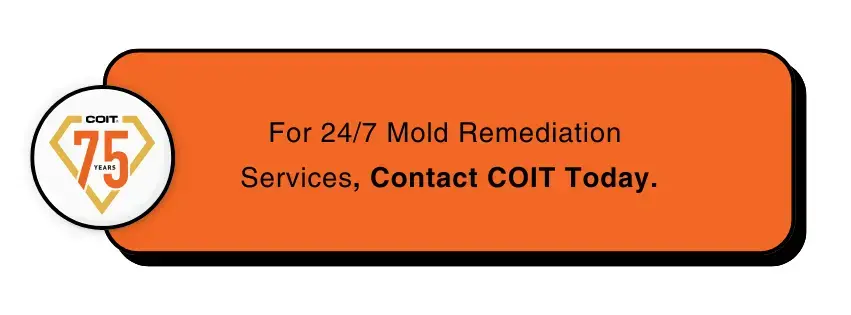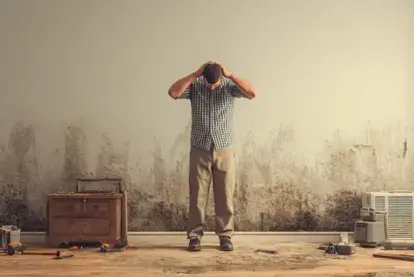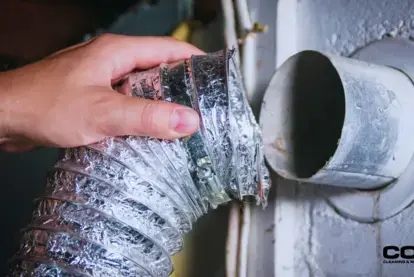
How to Prepare for Mold Remediation
Contact COIT for a professional cleaning!
If you're facing a mold issue in your home, you’ll eventually have to prepare for remediation. Mold remediation is a critical process for getting rid of mold and maintaining a healthy living environment.
This guide will walk you through the essential steps to prepare for mold remediation, ensuring a smooth and effective process.
Whether it's protecting your belongings, checking for safety concerns, or preparing the affected area, these tips from COIT will help you get ready for professional mold removal.
Understanding Mold Remediation
Mold remediation involves a series of steps to effectively remove mold from your home and prevent its return.
It's more than just a simple cleaning—it involves identifying the source of the mold, containing its spread, removing contaminated materials, and restoring the area to its original condition.
How do you prepare for mold treatment?
Preparing your home or property for mold treatment involves several steps:
- Start by identifying the areas with mold growth. It's crucial to isolate these areas to prevent the spread of mold spores during the remediation process.
- Clear out the affected area, removing furniture, rugs, and personal items. This not only makes the remediation process easier but also protects your belongings from potential damage.
- Wrap and store valuable items in a mold-free zone. If you have items that are sensitive or irreplaceable, consider moving them off-site during the remediation process.
- Ensure there is a clear path for the remediation team to access the affected area. This helps in preventing the spread of mold to other parts of your home.

Should you be in the house during mold remediation?
It's generally recommended that occupants stay out of the house during the mold remediation process, especially if you have allergies or respiratory issues. Here's why:
- Mold remediation can disturb spores, which may affect indoor air quality temporarily.
- It allows professionals to work more efficiently without any interruptions.
How long should you stay out of the house after mold remediation?
The duration you should stay out of your house post-remediation depends on the extent of mold and the areas treated. On average, it could be a few hours to several days. Always follow the advice of the remediation professionals.
How do you prepare a room for mold remediation?
To prepare a room for mold remediation, be sure to do the following:
- Seal off the room with plastic sheeting and tape. Cover air vents to prevent mold spores from spreading through the HVAC system.
- Remove or cover all furniture and belongings in the room to protect them from mold spores and cleaning agents.
To protect your belongings:
- Store belongings in a dry, mold-free environment.
- Clean items before storage and wrap them in plastic to protect from dust and spores.
- Inspect items for mold growth. If contaminated, consider professional cleaning or disposal.
What do you throw away after mold remediation?
Items that are porous and heavily contaminated with mold, such as cardboard, carpet, and upholstered furniture, may need to be discarded. It's often difficult to completely remove mold from these materials.
How likely is mold to come back after remediation?
Mold thrives in moist environments, and if the source of moisture is not addressed, mold can return. Common moisture sources include leaks, condensation, high humidity, and flooding.
The likelihood of mold returning can also be influenced by the general climate and weather patterns in your area. Humid climates or rainy seasons might require more rigorous monitoring and preventive measures.

Working with Professionals for Effective Mold Remediation
Understanding the likelihood of mold returning after remediation leads directly into the importance of working with professional mold remediation services.
When working with professionals, remember the following:
Selecting the Right Professional Service
Research and choose a reputable mold remediation company like COIT that has a track record of effective mold solutions. Look for certifications, reviews, and their approach to mold treatment.
Comprehensive Assessment
Expect a thorough assessment of your property. Professionals should not only identify visible mold but also use tools to detect hidden mold and moisture sources.
Customized Remediation Plan
Each mold situation is unique. Ensure the company provides a tailored plan that addresses the specific needs of your home, including the type of mold, the extent of the infestation, and the affected materials.
Clear Communication
Maintain an open line of communication with the remediation team. Don't hesitate to ask questions about the process, the materials and chemicals used, and any concerns you have.
Safety Protocols
Discuss the safety measures the team will use to protect your home and prevent the spread of mold spores during the remediation process. This includes containment strategies and protective equipment.
Timeline and Disruption
Get clarity on how long the process will take and how it will affect your daily routine. Professional remediation can range from a day to several days, depending on the severity of the mold problem.
Post-Remediation Inspection
After the remediation is complete, a thorough inspection should be conducted to ensure all mold has been removed. This may include air quality tests to confirm that the indoor environment is safe.
Warranty and Follow-Up
Inquire about any warranties or guarantees offered on their work. A reliable company will stand behind their service and offer follow-up inspections if needed.
Documentation
Request documentation of the remediation process for your records. This can be useful for insurance purposes and future property transactions.
Final Thoughts
Preparing for mold remediation is a crucial step in resolving mold issues in your home. By following these guidelines, you can ensure a safer and more effective remediation process.
If you're ready to tackle mold in your home, COIT’s professional services are here to help. Contact us for expert mold remediation and enjoy a healthier, mold-free living space.



